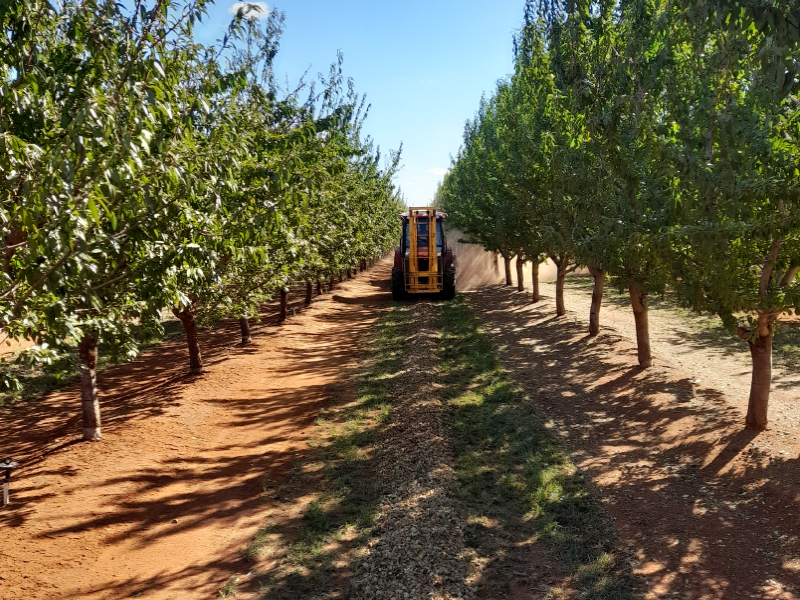
Hort Innovation's almond breeding program first began in 1997 and has since commercialised six new varieties that are performing better than previously available options. This long-standing investment runs a targeted breeding program to develop new almond varieties with improved production characteristics, while progressing the evaluation of varieties from earlier iterations of the program and from overseas breeding programs. The aim is to ultimately provide industry access to new varieties that are high yielding, with self-fertility, improved disease tolerance, closed shells and strong visual and eating qualities.
Meet Dr Michelle Wirthensohn
Research project lead Dr Michelle Wirthensohn from the University of Adelaide has been involved in the breeding program since its inception 22 years ago. She said the objective of the breeding program is to continue to develop new high-yielding self-fertile almond varieties with improved tree architecture, closed shell and disease resistance.
“When we first started this project more than two decades ago, the aim was to identify and breed new varieties so growers could have better long-term options. Back then there were only a few old varieties, and they lacked a strong taste profile and were mostly used for processing,” she said. “We needed to investigate ways to create a sustainable domestic almond industry that was robust and resilient and could thrive in a number of challenging conditions.”
“Disease resistance was important, as was producing high yield with the same water use. So, we set our sights on breeding varieties that would meet all of the industry’s standards and have successfully completed field trials which have shown that these varieties will set fruit without any insect intervention.”
Dr Michelle Wirthensohn said that Maxima and Mira were two of the five varieties that were released in 2016 and the initial aim for those varieties was higher productivity and self-fertility.
She said that “they are full siblings and come from the same cross, but Maxima didn’t get the self-fertile gene. Maxima does produce a huge kernel though – where Nonpareil averages 1.2 to 1.3 grams per kernel, Maxima averages around 1.9 grams and some markets love that huge kernel. Mira is self-fertile and produces more than the Maxima but has a smaller kernel. With Mira’s yield being higher in the long-term trials, it’s currently coming out on top.”
Meet almond growers Luke and Lucinda Englefield
Luke and Lucinda Englefield grow almonds in Mildura and have been involved in the industry for around a decade. Five years ago they made the decision to plant nine hectares of two new varieties (Maxima and Mira) developed through the almond breeding program.
“We decided to have a look at these varieties and began our research by talking with other growers, as well as the Industry Liaison Officer at the Almond Board of Australia, about the opportunities and risks involved,” said Luke Englefield.
“We knew that almost 30 years of research had gone into getting the varieties to this point in the breeding program. We also trusted the people involved with steering the project and their desire to breed innovative varieties that are easier to farm in Australia and don’t have as many of the problems that our current commercial varieties have.”
“Previously we were dealing with two or three different types of kernel bugs that appear at harvest time. They’re very hard to control and although we use orchard hygiene methods, it’s not perfect. These new varieties don’t have that problem because they’ve been bred to have different characteristics.”
“We didn’t want to continue dealing with the same issues the almond industry has had for the past 20 years when we could try something different that could be better. And so far, we’ve found these varieties easier to farm – we don’t have to worry as much about the main pests that we don’t quite know how to control. For us, the aim was to do better with less inputs. If I could plant more almond trees, I would choose to plant more of these varieties. One of them requires a lot less bees and they both require a lot less insecticides.”
“The way I see it is that there’s risk involved both ways. There’s risk in continuing to do the same thing you’ve always done for 30 years, where you don’t fully understand how to control the pests and diseases you’re coming up against. But there’s also risk in trying something new.”
“At the moment we’re seeing a lot of almond growers dipping their toes into trying the new varieties – starting with a small selection of their orchard before they make a larger commitment.”
“There are royalties that need to be paid on every tree, which is a significant upfront cost in planting a new variety. However, when you compare that cost against 20 years of using extra efforts needed to control carob moth and other pests and diseases linked with the conventional varieties, you’ll actually be in front.”
“I think that increased pressures on bee supply for pollination will encourage other almond growers to consider new varieties that seem to be more efficient. Trees that need less bees and less chemical inputs, while still maintaining yields, are going to provide better returns for growers. At the moment it seems to be the more innovative leaders who are taking advantage of this opportunity, but for me it was very much a commercial choice. I guess I’ll be able to tell you in 20 years whether the decision was a winner!”
Dr Wirthensohn said the breeding program is now aiming to produce varieties which are resistant to diseases such as almond hull rot – which costs the industry millions of dollars in production losses each year and bacterial spot disease – both common plant diseases that affect plant productivity.
“We’re also looking to increase the diversification of current varieties for the almond industry by 2023; incorporating a selection of new self-fertile varieties with larger kernels, higher yields; and improved pollinators for Nonpareil,” she said.
